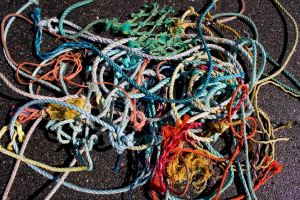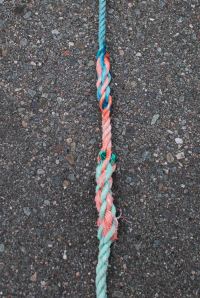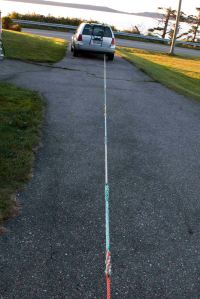One Good Rope

Besides all of the tangled masses of long rope that I have been finding caught in the rocks, I’ve been collecting short bits that appear in the mats of flotsam on the beach. The range of colors is amazing: blue, green, yellow, orange and several pastel shades. Looking at my collection in a pile, you’d think there had been a celebration, but, thinking about the extension cords that often snake around my feet in my studio, different colors make it easier to keep the mess untangled; or, like the mass of wires in the guts of a car’s fuse box, the colors make it possible to trace one line from what would otherwise be a mess of monochromatic spaghetti. On a fishing boat, it must be hard enough just to stay on your feet, much less keep track of which rope goes to what. Hopefully, not many fishermen are color blind.
Many of the pieces have these wonderful splices in them, which look like the braids of a rag rug, either to join two or sections or to make a loop or an end. The pieces range from one to several feet in length are about one-half to three-quarters of an inch thick. All rope is made the same way: three distinct strands formed from fine fibers twist around each other in a counter-clockwise direction. The strands themselves are tightly wound in a clockwise direction so that the twisting actions work against each other and hold it all together. The more stress applied, the more the rope binds on itself. A rope can be made as long as needed regardless of the length of the fine fibers, which can be jute, hemp, cotton, nylon or, as in the case most beach rope, polypropylene, which floats and doesn’t biodegrade. A splice simply weaves the strands of two ends together, or in the case of a loop, an end back into itself. I’ve decided to take all of these cast off pieces and make one long rope.
Over the years, I’ve come to appreciate rope. As a Boy Scout, I learned how to tie knots and lash together sticks to make lean-tos and towers. Later, as a house painter, the antiquated scaffold hoist that I used relied on ropes to take me up and down the side of a house so I could work half a day without touching the ground. I inspected my ropes regularly; like a rock climber, I knew my life depended on them. Years later, working on the Cayuga Lake Triathlon, I had to come up a system to create a half-mile long string of buoys that would define the swim course. We used one length of yellow polypropylene, splicing in loops for buoy clips and anchors so that it could be rapidly deployed. Looking at old race day photos, I know, this experience informed later projects, like the 1500 foot line of stones I created in the Oregon high desert. A line in the landscape can imply an almost infinite scale; physically manifest as fence or road or a rope, it is the perfect marriage of the abstract to the tangible. Like a yellow police tape, a line can be seemingly insignificant and, yet, can impose unmistakeable consequences. Rope is also pretty handy stuff; it is one of those things, like the wheel, that defines civilization, yet, unlike other technology, it is pretty much unchanged and it is certainly less glamorized. Its perfection lies in its simplicity and the way it utilizes the natural tendency of things to twist and bind on them selves. Pulled taut into a straight line, it is perfectly stable; left to the forces of nature, it will eventually curl into itself and form a useless tangle.
As I work and teach myself the splicing process, I find that the easiest way to work is to start a foot back from one end. After the strands of the second rope are weaved into the first, the extra rope is trimmed off. The floor of my work space is soon covered with all of these little ends and I begin think about all the short bits of plastic rope that litter the beaches. I realize that much of it is probably not lost, but simply discarded. Suddenly, reconstituting all of these bits into a new rope becomes an indictment of those who live off of the sea.
My spliced rope is almost 100 feet long now and made of twenty or so pieces. Much of the rope is worn and frayed but the splices look pretty good (but not as good as the fishermen’s), so I know they will hold under stress. The project would be meaningless if the rope wasn’t strong, so I test it by tying one end to my car and the other to a tree. As I release my clutch, the rope binds on itself and the engine bucks and stalls. That is one good rope.





What you are doing with the rope pieces is so satisfying to my sensiblities of not wasting anything… of fixing the broken to make it useable again–though in your case, usable for much different uses than originally intended. You have lengths of colored, plastic rope un-entangled, found, discovered, and re-purposed.
You are testing the strength to see if the spliced rope is still functional for its primary use, but now it also has a new life. There are colored pieces of rope from individual lives–ropes cast out to make a living, then lost at sea.
Now woven together, these pieces of colors of rope from various lives are entwined with the commonality of originating from a vast expanse of salty water. Those people don’t know each other, but now are bound together into your one rope. That one rope is new to the world and has yet to have a clear pupose.
I can’t wait to see the photos–and the rope itself! Safe travels home!
Thanks Katrina,
You are right, there is so much to work with- material wise and in terms of ideas that spin off. I wish I could engage a bunch of school kids to continue the project. There are so many layers to this:cleaning the beach, reusing the rope, learning an old craft and carrying on traditions and thinking about about communities can diverse and strong; the woven sections of contrasting colors are the most vibrant! Sadly, I have to return to work.